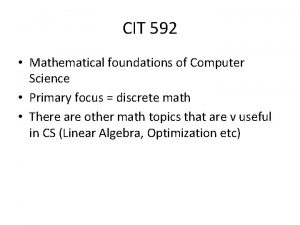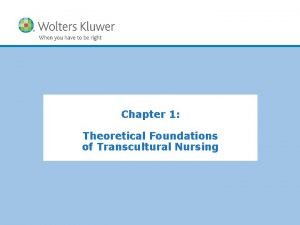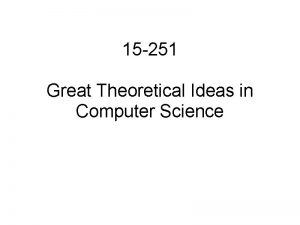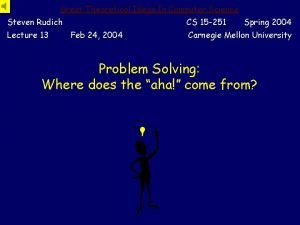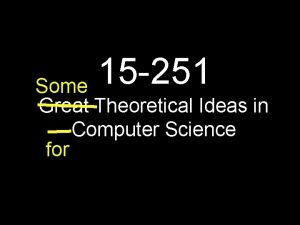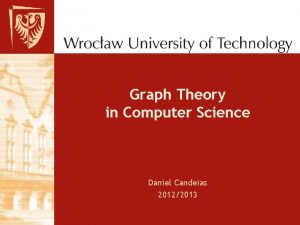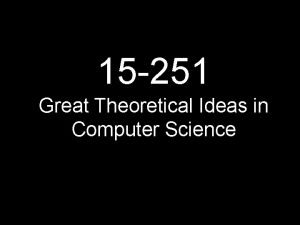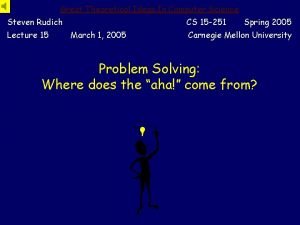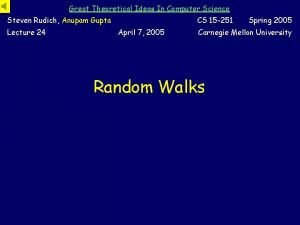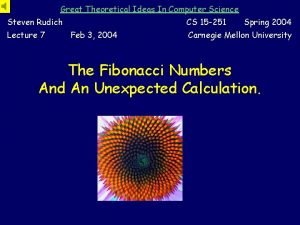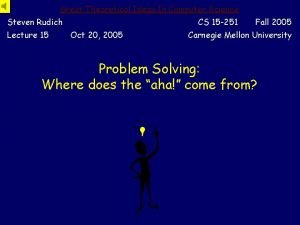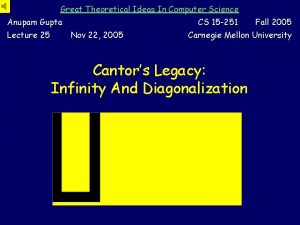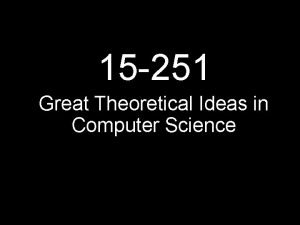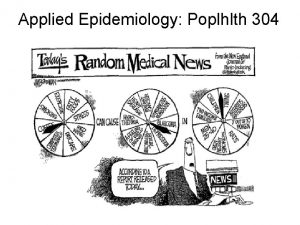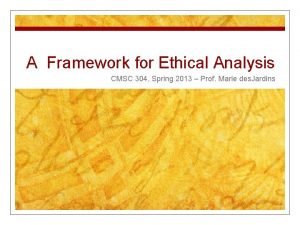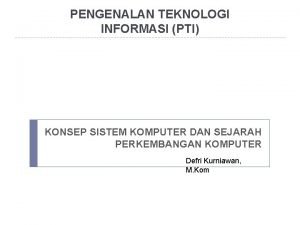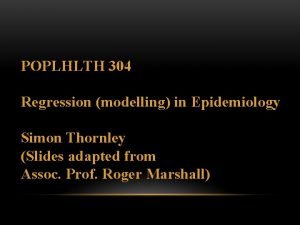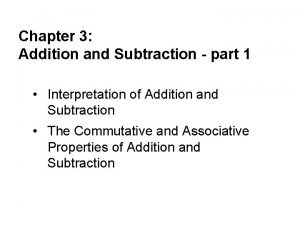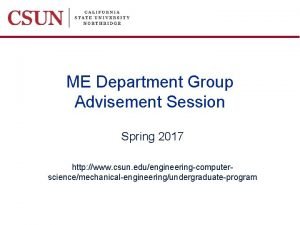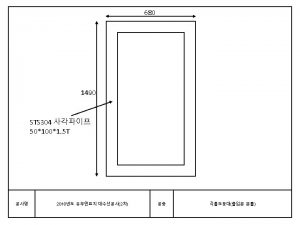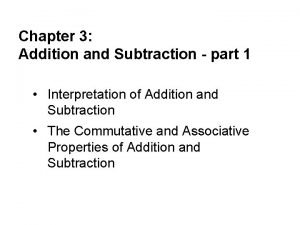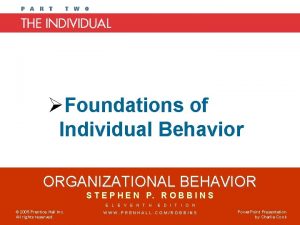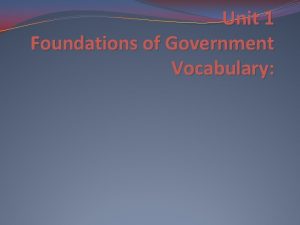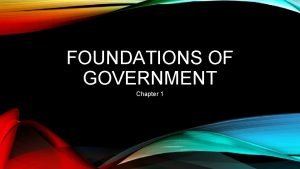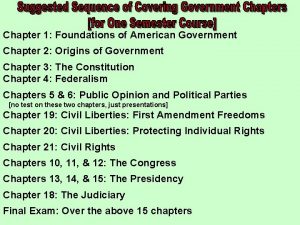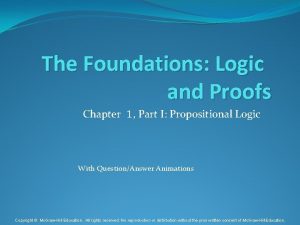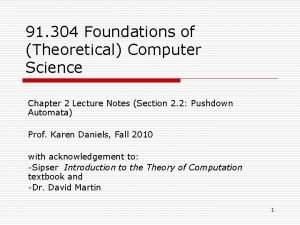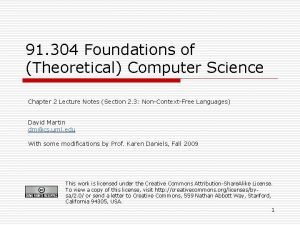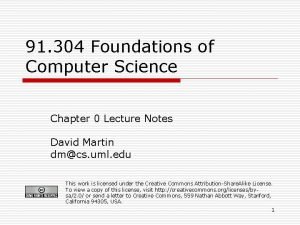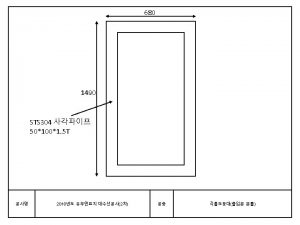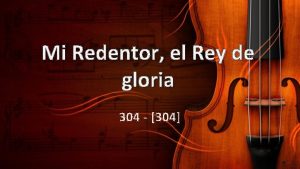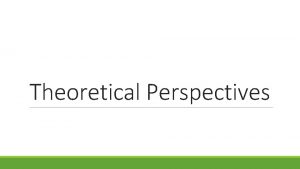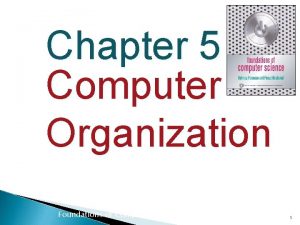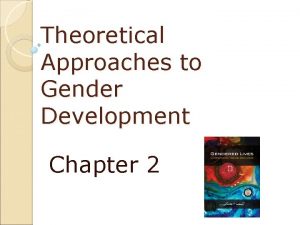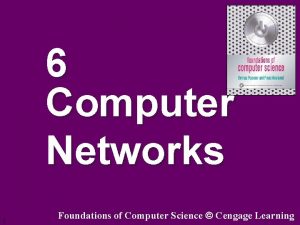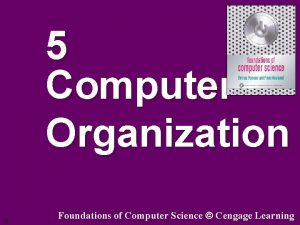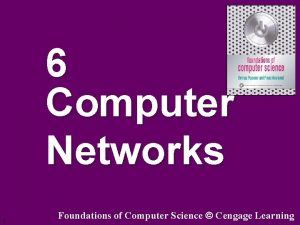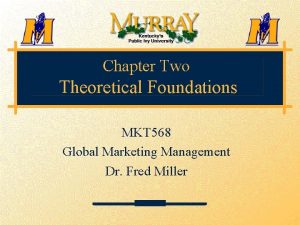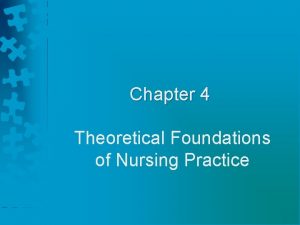91 304 Foundations of Theoretical Computer Science Chapter










































- Slides: 42

91. 304 Foundations of (Theoretical) Computer Science Chapter 4 Lecture Notes (Section 4. 2: The “Halting” Problem) David Martin dm@cs. uml. edu With modifications by Prof. Karen Daniels, Fall 2009 This work is licensed under the Creative Commons Attribution-Share. Alike License. To view a copy of this license, visit http: //creativecommons. org/licenses/bysa/2. 0/ or send a letter to Creative Commons, 559 Nathan Abbott Way, Stanford, California 94305, USA. 1

Back to 1 o o So the fact that 1 is not closed under complement means that there exists some language L that is not recognizable by any TM By Church-Turing thesis this means that no imaginable finite computer, even with infinite memory, could recognize this language L! 2

Non-recognizable languages o We proceed to prove that non-Turing recognizable languages exist, in two ways: n n A nonconstructiveproof using Georg Cantor’s famous 1873 diagonalization technique, and then An explicit construction of such a language. 3

A nonconstructive proof o Let L µ {0, 1}* be defined by: Is L decidable? o Yes; there exists a machine M that recognizes the appropriate language; we just don’t know what machine it is right now. 4

Learning how to count o o Definition Let A and B be sets. Then we write A ¼ B and say that A is equinumerousto B if there exists a one-to-one, onto function (a “correspondence”) f : A ! B Note that this is a purely mathematical definition: the function f does not have to be expressible by a Turing machine or anything like that. Example: { 1, 3, 2 } ¼ { six, seven, BBCCD } Example: N ¼ Q (textbook example 4. 15) n See next slide… 5

Learning how to count o (continued) Example: N ¼ Q (textbook example 4. 15) 6 Source: Sipser textbook

Countability o Definition A set S is countableif S is finite or S ¼ N. n n Saying that S is countable means that you can line up all of its elements, one after another, and cover them all Note that R is not countable (Theorem 4. 17), basically because choosing a single real number requires making infinitely many choices of what each digit in it is (see next slide). 7

Countability o o (continued) Theorem 4. 17: R is not countable. Proof Sketch: By way of contradiction, suppose R ¼ N using correspondence f. Construct R such that x is not paired with anything in N, providing a contradiction. x is not f (n) for any n because it differs from f (n) in nth fractional digit. Caveat: How do circumvent 0. 1999…= 0. 2000… problem? 8 Source: Sipser textbook

L 2 ALL - 1 A non- 1 language ALL 1 CFPP RPP 0 CFL REG Each point is a language in this Venn diagram FIN 9

Strategy o We’ll show that there are more (a lot more) languages in ALL than there are in 1 n n n o Namely, that 1 is countable but ALL isn’t countable Which implies that 1 ALL Which implies that there exists some L that is not in 1 For simplicity and concreteness, we’ll work in the universe of strings over the alphabet {0, 1}. 10

Countability of 1 o o Theorem 1 is countable Proof The strategy is simple. 1 is the class of all languages that are Turing-recognizable. So each one has (at least) one TM that recognizes it. We’ll concentrate on listing those TMs. 11

Countability of TM o Let TM = { <M> | M is a Turing Machine with ={0, 1} } n Notation: <M> means the string encodingof the object M n Previously, we thought of our TMs as abstract mathematical things: drawings on the board, or 7 -tuples: (Q, , q 0, qa, qr) n But just as we can encode every C++ program as an ASCII string, surely we can also encode every TM as a string n It’s not hard to specify precisely how to do it—but it doesn’t help us much either, so we won’t bother n Just note that in our full specification of a TM (Q, , q 0, qa, qr), each element in the list is finite by definition n So writing down the sequence of 7 things can be done in a finite amount of text o In other words, each <M> is a string 12

Countability of TM o o o Now we make a list of all possible strings in lexicographical order, Cross out the ones that are not valid encodings of Turing Machines, And we have a mapping f : N ! TM n n n o f (1) = first (smallest) TM encoding on list f (2) = second TM encoding on list. . . This is part of textbook’s proof of Corollary 4. 18 (Some languages are not Turingrecognizable). 13

Back to countability of 1 o Now consider the list L(f (1)), L(f (2)), n n n Turns each TM enumerated by f into a language So we can define a function g : N ! 1 by g(i) = L(f (i)), where f (i) returns the ith Turing machine Now: is this a correspondence? Namely, o o Is it onto? Is it one-to-one? 14

Fixing g : N ! 1 o o o Go ahead and make the list g(1), g(2), But cross out each element that is a repeat, removing it from the list Then let h : N ! 1 be defined by h(i) = the ith element on the reduced list Then h is both one-to-one and onto Thus 1 is countable 15

What about ALL? o Theorem(Cantor, 1873) For every set A, A n n o o o P(A) See next several slides for proof. See textbook for a different way to show ALL is uncountable using characteristic sequence associated with (uncountable) set of all infinite binary sequences. Remember ALL = P({0, 1}*) n set of all ( languages ) = set of all (subsets of {0, 1}* ) Note that {0, 1}* is countable n Just list all of the strings in lexicographical order Corollary to Theorem. ALL = P({0, 1}*) is uncountable n So 1 is countable but ALL isn’t n So they're not equal 16

Cantor’s Theorem. For every set A, A P(A) Proof We’ll show by contradiction that no function f: A!P(A) is onto. So suppose f: A!P(A) is onto. We define a set KµA in terms of it: K={ x 2 A | x f(x) } Since KµA, K 2 P(A) as well (by definition of P). Since f is onto, there exists some z 2 A such that f(z) = K. Looking closer, z 2 K ) z f(z) ) z K by definition of z so z 2 K certainly can’t be true. . . 17

Cantor’s Theorem unchanged K={ x 2 A | x f(x) } K 2 P(A) z 2 A and f(z) = K On the other hand, z K ) z 2 f(z) ) z 2 K by definition of K so z by definition of z K can’t be true either! QED 18

Cantor’s Theorem: Example o o o For every proposed f : A!P(A), theorem constructs a set K 2 P(A) that is not f(x) for any x Let A = { 1, 2, 3 } P(A)={ ; , {1}, {2}, {3}, {1, 2}, {2, 3}, {1, 2, 3} } Propose f : A!P(A), show K 19

Diagonalization o o o All we’re really doing is identifying the squares on the diagonal and making them different than what’s in our set K So that we’re x guaranteed K f(1), K f(2), 1 The construction works 2 for infinite sets too 3 f(x) {¥ , _ , _ } {_ , ¥, _ } {_ , ¥ } 20

Non-recognizable languages o o So we conclude that there exists some L 2 ALL - 1 (many such languages) But we don’t know what any L looks like exactly Turing constructed such an L also using diagonalization (but not the relation) We now turn our attention to it 21

Programs that process programs o In § 4. 1, we considered languages such as o Each element of ACFG is a coded pair ACFG = { <G, w> | G is a CFG and w 2 L(G) } n n n o Meaning that the grammar G is encoded as a string and w is an arbitrary string and <G, w> contains both pieces, in order, in such a way that the two pieces can be easily extracted The question “does grammar G 1 generate the string 00010? ” can then be phrased equivalently as: n Is <G 1, 00010> 2 ACFG ? 22

Programs that process programs o o o ACFG = { <G, w> | G is a CFG and w 2 L(G) } The language ACFG somehow represents the question “does this grammar accept that string? ” Additionallywe can ask: is ACFG itself a regular language? context free? decidable? recognizable? n We showed previously that ACFG is decidable (as is almost everything similar in § 4. 1) 23

ATM and the Universal TM o o ATM = { <M, w> | M is a TM and w 2 L(M) } We will show that ATM 2 1 - 0 n o (It’s recognizable but not decidable) Theorem ATM is Turing-recognized by a fixed TM called U (the Universal TM) n This is not stated as a theorem in the textbook (it does appear as part of proof of Theorem 4. 11: ATM is undecidable), but should be: it’s really important 24

ATM = L (U) ATM = { <M, w> | M is a TM and w 2 L(M) } U is a 3 -tape TM that keeps data like this: 1 2 3 <M> q c 1 c 2 c 3 never changes a state name tape contents & head pos On startup, U receives input <M, w> and writes <M> onto tape 1 and w onto tape 3. (If the input is not of the form <M, w>, then U rejects it. ) From <M>, U can extract the encoded pieces (Q, , q 0, qacc, qrej) at will. It continues by extracting and writing q 0 onto tape 2. 25

ATM = L (U) ATM = { <M, w> | M is a TM and w 2 L(M) } 1 2 3 <M> q c 1 c 2 c 3 never changes a state name tape contents & head pos To simulate a single computation step, U fetches the current character c from tape 3, the current state q on tape 2, and looks up the value of (q, c) on tape 1, obtaining a new state name, a new character to write, and a direction to move. U writes these on tapes 2 and 3 respectively. If the new state is qacc or qrej then U accepts or rejects, respectively. Otherwise it continues with the next computation step. 26

The Universal TM U o o This U is hugely important : it’s theoretical basis for programmable computers. It says that there is a fixed machine U that can take computer programs as input and behave just like each of those programs n n o Note that U is not a decider See VMware Since ATM = L(U), we have shown that ATM is Turing-recognizable ( 1) 27

The “Halting” Problem o o ATM = {<M, w> | M is a TM and w This appears in our textbook as: n n L(M)} ATM = { <M, w> | M is a TM and M accepts w } This emphasizes the fact that U might loop (i. e. might not halt) on input <M, w>. ATM is therefore sometimes called the halting problem. We use “” here due to Chapter 5’s discussion… o o ATM is called the acceptance problem in Chapter 5 The “real” halting problem is defined there as: n HALTTM = { <M, w> | M is a TM and M halts on input w } 28

ATM is undecidable Theorem 4. 11 (Turing) ATM 0 Proof Suppose that ATM=L(H) where H is a decider. We’ll show that this leads to a contradiction. H(<M, w>) = accept if M accepts w reject if M does not accept w Let D be a TM that behaves as follows: 1. Input x 2. If x is not of the form <M> for some TM M, then D rejects Input M’s 3. Simulate H on input <M, <M> > description! o o If H accepts <M, <M>>, then D rejects If H rejects <M, <M>>, then D accepts Do the opposite! 29

“Simulate H” o o Steps 1 and 2 are not so hard to imagine How does D “simulate H on (some other input)”? n n o If someone creates an H, we follow this outline to build D — which has the entire H program built in as a subroutine Note we run H on a different input than the one that D is given Also, we didn’t say what D does if H goes into an infinite loop n It’s OK because H does not do that, by the assumption that H is a decider 30

Language accepted by D (Repeat) D behaves as follows: 1. 2. 3. D: input x if x is not of the form <M> for some TM M, then D rejects simulate H on input <M, <M> > o o If H accepts <M, <M>>, then D rejects If H rejects <M, <M>>, then D accepts So L(D)={ <M> | H rejects <M, <M>> } Now H is a recognizer (even a decider) for ATM, so if H rejects <M, <M>> then it means that the machine M does not accept<M>. So L(D)={ <M> | <M> L(M) } 31

Impossible machine o o So L(D)={ <M> | <M> L(M) } What if we give a copy of D’s own description <D> to itself as input? As in Cantor’s theorem, we have trouble: n n o <D> 2 L(D) ) <D> L(D) !! <D> L(D) ) <D> 2 L(D) !! So this D can’t exist. But it was defined as a fairly straightforward wrapper around H: so H must not exist either. That is, there is no decider for ATM. QED 32

To summarize… H accepts <M, w> exactly when M accepts w. D rejects <M> exactly when M accepts <M>. D rejects <D> exactly when D accepts <D>. 33

Diagonalization in this proof? Mi is a TM. Blank entry implies either loop or reject. Now consider H, which is a decider. 34 Source: Sipser textbook

Diagonalization in this proof? (cont. ) D computes the opposite of each diagonal entry because its behavior is opposite H’s behavior on input <Mi, <Mi>>. 35 Source: Sipser textbook

Current landscape ALL ATM 2 1 - 0 1 CFPP RPP 0 CFL REG Each point is a language in this Venn diagram FIN 36

Decidability versus recognizability Theorem 4. 22 For every language L, L 2 0 , (L 2 1 and Lc 2 1) Recall that complement of a language is the language consisting of all strings that are not in that language. Proof The ) direction is easy, because 0µ 1 and 0 is closed under complement. For the ( direction, suppose that L 2 1 and Lc 2 1. Then there exist TMs so that L(M 1)=L and L(M 2)=Lc. To show that L 2 0, we need to produce a decider M 3 such that L=L(M 3). 37

Theorem 4. 22 continued L(M 1)=L, L(M 2)=Lc, and we want a decider M 3 such that L=L(M 3) Strategy: given an input x, we know that either x 2 L or x 2 Lc. So M 3 does this: 1. 2. 3. M 3: input x set up tape #1 to simulate M 1 on input x and tape #2 to simulate M 2 on input x compute one transition step of M 1 on tape 1 and one transition step of M 2 on tape 2 o o o if M 1 accepts, then M 3 accepts if M 2 accepts, then M 3 rejects else goto 3 This is like running both M 1 and M 2 in parallel. 38

Theorem 4. 22 conclusion o For each string x, either M 1 accepts x or M 2 accepts x, but never both n n o So the machine M 3 will always halt eventually in step 3 Therefore, M 3 is a decider M 3 accepts those strings in L and rejects those strings in Lc n So L(M 3) = L QED 39

Getting a non-recognizable language from ATM o o o L 2 0 , (L 2 1 and Lc 2 1) L 0 , (L 1 or Lc 1) Now since we know that ATM 0, and we know that ATM 2 1, it must be true that ATMc 1. n n o ATM = {<M, w> | M is a TM and w 2 L(M) } ATMc = { x | x is not of the form <M, w> or (x=<M, w> and w L(M) ) } If we narrow this down to strings of the form <M, w>, then the language is still unrecognizable: n NATM = { <M, w> | M is a TM and w L(M) } 40

Unrecognizability o NATM = {<M, w> | M is a TM and w o What does it mean that NATM is unrecognizable? n n o L(M) } Every TM recognizes a language that’s different than NATM Either it accepts strings that are not in NATM, or it fails to accept some strings that actually are in NATM Analogy to C programs: n Write a C program that takes another C program as input and prints out “loop” if the other C program goes into an infinite loop. 41

Current landscape NATM 2 ALL - 1 ALL ATM 2 1 - 0 1 CFPP RPP 0 CFL REG Each point is a language in this Venn diagram FIN 42
 Cit592
Cit592 Transcultural interprofessional practice model
Transcultural interprofessional practice model Great theoretical ideas in computer science
Great theoretical ideas in computer science Great theoretical ideas in computer science
Great theoretical ideas in computer science Great theoretical ideas in computer science
Great theoretical ideas in computer science In computer
In computer 15 251
15 251 Great theoretical ideas in computer science
Great theoretical ideas in computer science Great theoretical ideas in computer science
Great theoretical ideas in computer science Great theoretical ideas in computer science
Great theoretical ideas in computer science Vocabularize
Vocabularize Great theoretical ideas in computer science
Great theoretical ideas in computer science Great theoretical ideas in computer science
Great theoretical ideas in computer science My favorite subjects are english mathematics and science
My favorite subjects are english mathematics and science Mathematical foundations of computer graphics and vision
Mathematical foundations of computer graphics and vision Ptt 304
Ptt 304 Geneva304hac
Geneva304hac Poplhlth 304
Poplhlth 304 Cmsc 304 umbc
Cmsc 304 umbc Ncr serie 304
Ncr serie 304 Iis 304
Iis 304 Poplhlth 304
Poplhlth 304 Parts of subtraction problem
Parts of subtraction problem Csun ece 240
Csun ece 240 Memorex 304
Memorex 304 Larimer county child protective services
Larimer county child protective services Premier poc03m
Premier poc03m Sts304 pipe
Sts304 pipe Matteo is 4 feet 3 inches tall
Matteo is 4 feet 3 inches tall Chapter 6 lesson 1 foundations of a healthy relationship
Chapter 6 lesson 1 foundations of a healthy relationship Chapter 6 skills for healthy relationships lesson 1
Chapter 6 skills for healthy relationships lesson 1 Chapter 2 the nursing assistant and the care team
Chapter 2 the nursing assistant and the care team Chapter 2 foundations of individual behavior
Chapter 2 foundations of individual behavior Chapter 1: foundations of government
Chapter 1: foundations of government Chapter 4 foundations background to american history
Chapter 4 foundations background to american history Foundation in personal finance chapter 1 answers
Foundation in personal finance chapter 1 answers Foundations of government vocabulary
Foundations of government vocabulary Chapter 1: foundations of government pdf
Chapter 1: foundations of government pdf Foundations of government (chapter 1 test form a)
Foundations of government (chapter 1 test form a) Computer science illuminated chapter 4 answers
Computer science illuminated chapter 4 answers Invitation to computer science chapter 10 answers
Invitation to computer science chapter 10 answers Chemistry central science 14th edition
Chemistry central science 14th edition Equivalent disjunctive form example
Equivalent disjunctive form example
